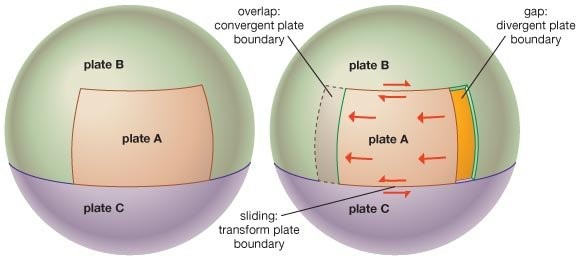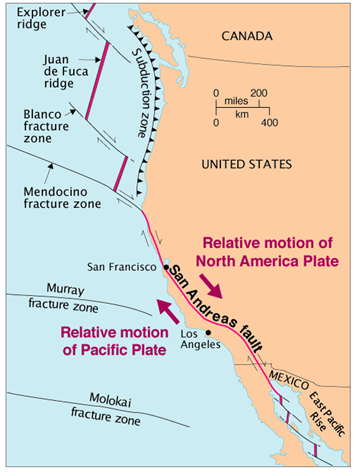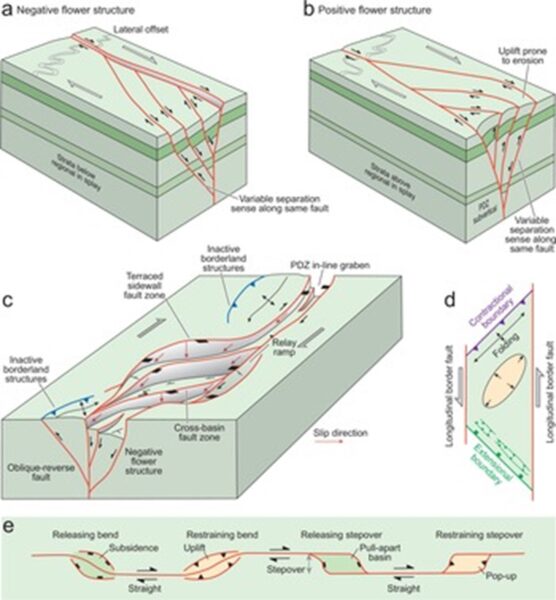Contact Us
Tuesday 4th July 2023 | Blog written by Neil McLauchlan, Route Engineer

Transform boundaries are features that allow transform faulting to occur, either in a sinistral (left) or dextral (right) manner. This allows the tectonic plates to slide past each other, or side by side at different speeds, without creating or destroying any lithosphere. Transform boundaries mainly occur at mid-ocean ridges (Mid-Atlantic Ridge), where they allow for offsets of the ridge as the crust expands over a sphere, and occasionally differing expansion rates along the same ridge. However, transform boundaries are also known to occur at boundaries where two or more convergences are taking place (Alpine Fault), and they can also connect divergent and convergent boundaries (San Andreas Fault).
Earthquakes are commonplace along transform boundaries. Earthquakes can cause several hazards to cable routes: liquefaction can occur in seafloor sediments causing the cable to be buried deeper or exposing it at the surface; movement of sediment in landslides can damage the cable as deposition occurs; landslides can cause tsunamis which can also cause damage to cables. Also, if a cable is laid across a transform fault, the juxtaposition of the plates over the lifecycle of a cable could influence the position of a cable, especially if it is buried. Therefore, the spreading rate, earthquake frequency, and the movement rate should be investigated before cable lay operations begin.


Transform faults can occur as a single fault or a parallel series. They are also capable of producing transpressional or transtensional faults. Transpressional faults create a compressional force, usually in a bend, that allow orogeny to take place. These are called restraining bends. Sometimes the mountains created by these forces rotate in an antithetic manner. Transtensional faults create an extensional force at a releasing bend along the fault, allowing grabens to occur, which could lead to new oceanic crust to being developed into a pull-apart basin (Dead Sea).

Although there are no volcanoes at transform boundaries, hydrothermal vents are often nearby in marine environments. Additionally, earthquakes are commonplace along transform boundaries. As the tectonic plates become stuck, friction occurs and pressure builds. When the pressure is released, it releases energy, causing displacement resulting in an earthquake. Earthquakes that occur at a transform boundary are generally very destructive because they are close to the Earth’s surface. Movement rates vary along transform faults dependant on the energy released and how often movement occurs. Movement could be several centimetres, it could be metres. Earthquakes can cause several hazards to cable routes: liquefaction can occur in seafloor sediments causing the cable to be buried deeper or exposing it at the surface; movement of sediment in landslides can damage the cable as deposition occurs; landslides can cause tsunamis which can also cause damage to cables. Also, if a cable is laid across a transform fault, the juxtaposition of the plates over the lifecycle of a cable could influence the position of a cable, especially if it is buried. Therefore, the spreading rate, earthquake frequency, and the movement rate should be investigated before cable lay operations begin.
References:
BGS, 2022. What causes earthquakes? British Geological Survey. Available at: https://www.bgs.ac.uk/discovering-geology/earth-hazards/earthquakes/what-causes-earthquakes/
CEA, 2020. Understanding Plate Tectonic Theory. California Earthquake Authority. Available at: https://www.earthquakeauthority.com/Blog/2020/Understanding-Plate-Tectonic-Theory
Fossen, H., 2013. Structural Geology. Chapter 18: Strike-slip, transpression and transtension. Second edition. Cambridge University Press. Cambridge, UK.
GeolSoc, 2022. Plate Tectonics. The Geological Society. Available at: https://www.geolsoc.org.uk/Plate-Tectonics
Jackson, M. P. A., & Hudec, M. R., 2017. Salt Tectonics. Chapter 12: strike-slip salt tectonic systems. Cambridge University Press. Cambridge, UK.
Johnson, C., et al., 2017. An Introduction to Geology. Chapter 2 Plate Tectonics. Salt Lake Community College. Available at: https://opengeology.org/textbook/
King, H., 2005. Plate Tectonics. Geology.com. Available at: https://geology.com/plate-tectonics/
NOAA, 2022. What are the different types of plate tectonic boundaries? National Oceanic and Atmospheric Administration: Ocean Exploration. Available at: https://oceanexplorer.noaa.gov/facts/plate-boundaries.html
NOAA, 2022[1]. What is a hydrothermal vent? National Oceanic and Atmospheric Administration: National Ocean Service. Available at: https://oceanservice.noaa.gov/facts/vents.html
USGS, 2014. Understanding plate motions. US Geological Society. Available at: https://pubs.usgs.gov/gip/dynamic/understanding.html van Andel, T. H., 2022. Plate tectonics. Encyclopaedia Britannica. Available at: https://www.britannica.com/science/plate-tectonics

Neil is one of OceanIQ’s experienced Route Engineers